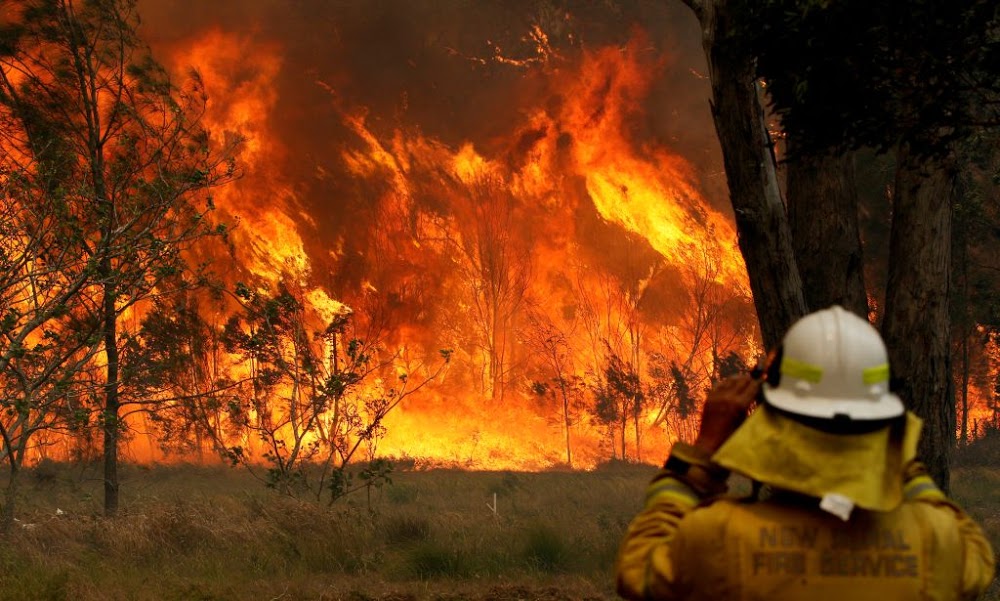When you think of Australia, the idea of near-constant bushfires is pretty standard – and you’re right! Bushfires are incredibly important to the Australian ecosystem – Australian plants are adapted to thrive after a bushfire, and given the hot and dry climate of the country, bushfires are inevitable and natural.
However, since September, Australia has been plagued with fires and, whilst bushfires are normal, the size and number of these fires is completely new and deeply concerning. There are fires quite literally all over the country, with New South Wales and Queensland being the worst hit states with over 1.6 million hectares devastated by fire, a 6,000km fire front, six lives lost and over 600 homes destroyed. A week-long State of Emergency was declared last fortnight for New South Wales, with ‘Catastrophic’ level fire warnings – the highest possible warning – being issued and the same recently issued in Victoria and South Australia as well. As Rural Fire Chief Shane Fitzsimmons put it, ‘Catastrophic’ fire warnings are when “people die”, and fire services have urged people to be prepared to evacuate at a moment’s notice.
So why has this happened? The reasoning is twofold: natural climatic cycles and climate change. The three main natural systems behind Australian climate are the Indian Ocean Dipole, the El Niño Southern Oscillation and the Southern Annular Mode. When in El Niño conditions, a negative phase of the Southern Annular Mode and a positive Indian Ocean Dipole, the Australian climate is drier and thus more intense bushfire conditions are generated. 2019 is just such a culmination of conditions, meaning that Australia was to expect a more intense bushfire season naturally.
However, whilst the fires are in part due to natural climate cycles, climate change has had an undeniable effect by prolonging and worsening the Australian bushfire season. Whilst more frequent and intense bushfires are not solely caused by climate change, the evidence overwhelmingly shows a clear and undeniable link between the two. The State of the Climate 2018 report for Australia showed a 10-20% reduction in rainfall across Southern Australia since the 1970s; the Bureau of Meteorology has noted a 1 °C increase in average temperature in Australia since 1910; and weekly bushfires increased 40% from 2011-2016. Droughts exacerbated by Climate Change are causing areas that traditionally do not burn, such as water courses, to literally evaporate – thus creating new fire paths. Regions of New South Wales have been in intense drought since 2017 and, unsurprisingly, are amongst the hardest hit by the fires.
Unfortunately, the response by the Australian government has been disappointing, to say the least. The current government, the Australian Liberal and National Party Coalition (LNP), alongside the second major party, the Australian Labor Party (ALP), have refused to acknowledge the link between climate change and the fires. The Australian Greens have reinvigorated their push for discussions on the climate emergency in the wake of the crisis, however this has been met with lacklustre and deeply insensitive responses. Deputy Prime Minister Michael McCormack said the links between the fires and climate change were “the ravings of some pure enlightened and woke capital city greenies”, and Barnaby Joyce, former National Party Leader and current backbencher, suggested that two victims of the fires “most likely” voted for The Greens. Prime Minister Scott Morrison has dismissed the comments, claiming that unhelpful remarks have been offered by both sides. Instead, his contribution was to offer his “thoughts and prayers” to those affected by the fire. For context, the Morrison government refused to meet with fire chiefs in April when they wanted to discuss the impact climate change presented in the upcoming fire season. Moreover, the LNP slashed $12.9 million from Fire and Rescue NSW, while the volunteer run Office of NSW Rural Fire Services lost $26.7 million in the 2019/20 budget. Additionally, during the Climate Strikes, Morrison was critical and urged students to go back to school – hundreds of schools across the country have now been closed due to the fires. The irony is not lost on anyone.
The fire season is only expected to worsen as summer does not officially start for another month and record temperatures have already been reached across the country. The intensity and destruction of these events is a frightening reality of climate change and to add to the apocalyptic feeling, in the midst of all this an intense hail storm with hail the size of cricket balls swept through the Gold Coast, all while Queensland was still battling fires. The time to act is now, because climate change is already here, whether we like it or not.
image source: https://www.sowetanlive.co.za/news/world/2019-11-09-australian-bushfires-kill-three-destroy-at-least-150-homes/

